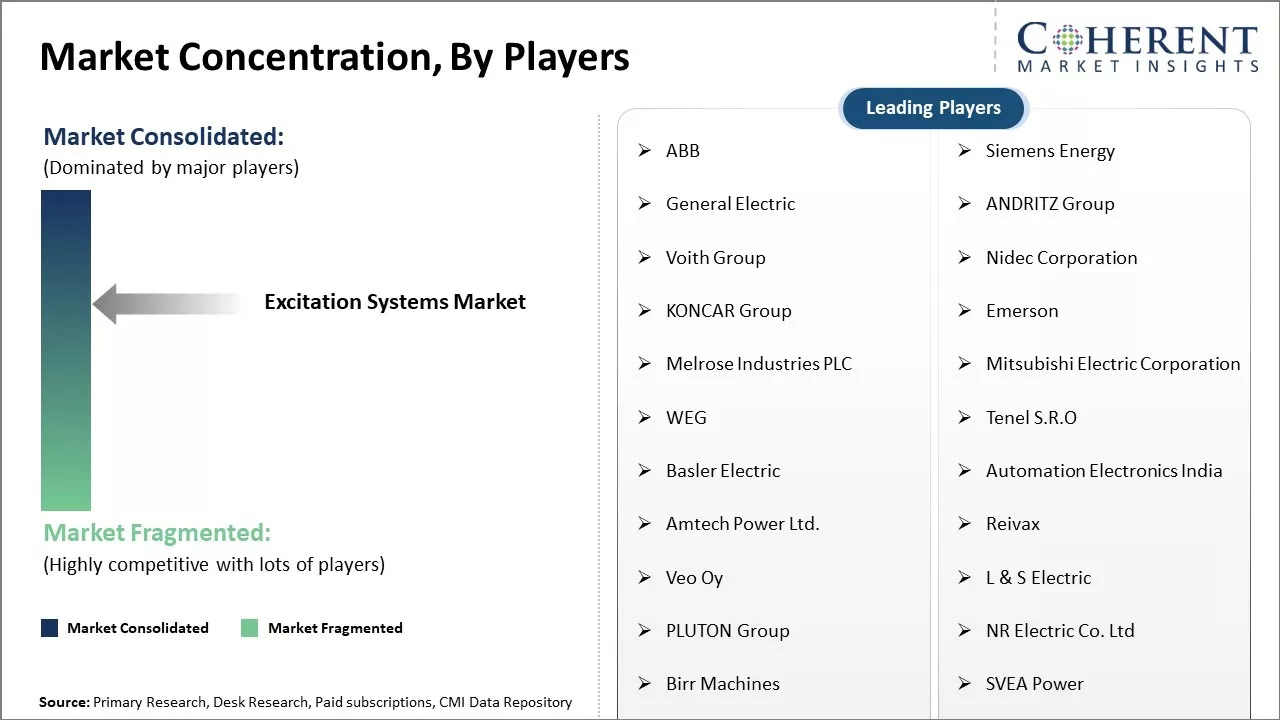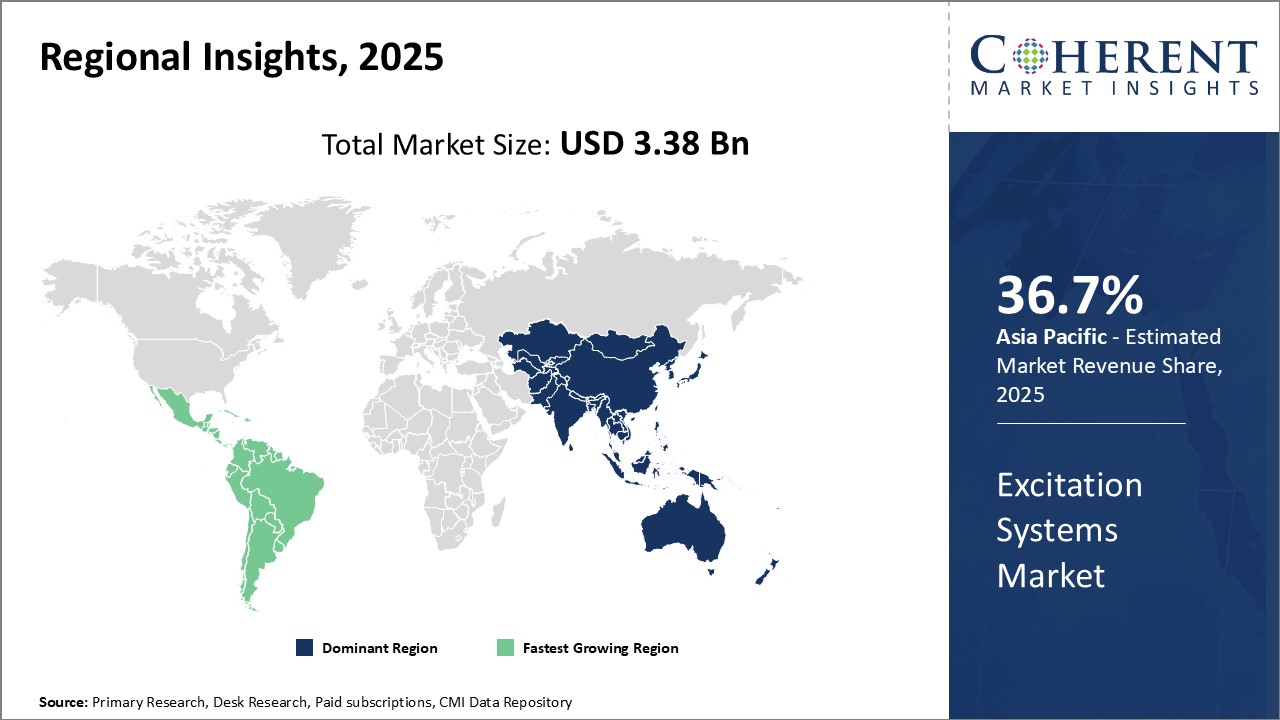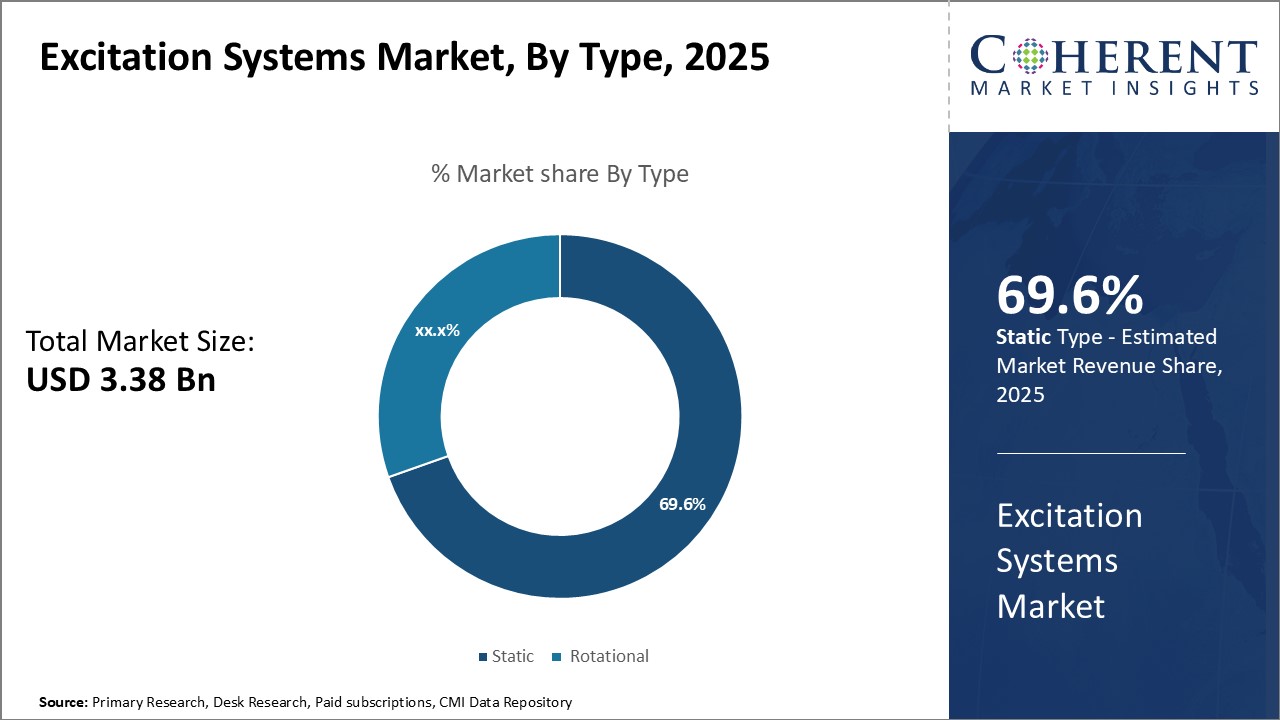Excitation Systems Market Analysis & Forecast: 2025-2032
The excitation systems market size is estimated to be valued at USD 3.38 Bn in 2025 and is expected to reach USD 4.54 Bn by 2032, growing at a compound annual growth rate (CAGR) of 4.3% from 2025 to 2032.

To learn more about this report, Download Free Sample
Key Takeaways
- By Type, Static Excitation Systems is expected to lead the market capturing a significant share of 69.6% by 2025 owing to the sustained efficiency and reliability improvements from ongoing technological advancements.
- By Controller Type, Digital Controllers are anticipated to have the largest excitation systems market share of 75.2% due to increase in adoption from precision and smart capabilities as fined centered technology advancements.
- By Application, Synchronous Generators are expected to hold the majority market share of 68.9% in 2025 due to feasibility and efficiency in power generation scalability.
- By Region, the Asia Pacific market is expected to lead the world market with a share of 36.7% in 2025 due to the rapid industrialization, increasing power infrastructure investment, and growing investment in modern excitation technologies.
Market Overview
The excitation systems market forecast is expected to witness significant growth over the forecast period. This is owing to rising demand for reliable power supply and increasing investments towards the modernization of existing power grids are some key factors driving the adoption of excitation systems. Additionally, the growing emphasis on the integration of renewable energy is also augmenting the demand for excitation systems that help stabilize power grids systems with intermittent power sources.
Current Events and Its Impact on the Excitation Systems Market
|
Event |
Description and Impact |
|
Accelerating Investment in Renewable Energy Projects on Global Scale |
|
|
Technological Advances Driving Smart Grid and Digital Innovations |
|
|
Supply Chain Disruptions and Critical Material Shortages |
|
Uncover macros and micros vetted on 75+ parameters: Get instant access to report
Market Concentration and Competitive Landscape

To learn more about this report, Download Free Sample
Excitation System Efficiency
Newer digital static excitation systems provide advanced field forcing capabilities which allows generators to operate closer to their maximum continuous rating. This improves generator capabilities without requiring additional capital expenditure on the generating unit itself. Static systems also facilitate load-dependent voltage regulation and transient stability support which boosts overall plant efficiency.
Technologies such as brushless exciters and fully controlled silicon diodes further enhance the power transfer efficiency from the auxiliary power source to the generator field. Overall efficiency gains from state-of-the-art static excitation systems range from 1% to 3% depending on the generator size and loading conditions.
For utilities with hundreds of generators in their fleet, such small efficiency improvements can translate into massive savings. Not only in terms of reduced fuel costs but also decreased maintenance needs and extended component life.
Compensation of Renewables
The increasing presence of intermittent renewable energy sources like solar and wind is presenting new operational challenges for thermoelectric generators and grid operators. The variable and sometimes erratic power output from renewables needs to be balanced instantaneously with alterable "dispatchable" resources to ensure grid stability at all times. Here excitation systems play a crucial role in providing critical frequency and voltage support to compensate for renewable power fluctuations.
Utility-scale solar and wind farms are already a major part of the energy mix in many regions worldwide. Moreover, the individual and cumulative impact of distributed rooftop solar installations on low voltage distribution grids is also rising substantially. Maintaining grid code compliance and power quality norms under these dynamic conditions requires generators to rapidly adjust their reactive power and terminal voltage capabilities.
Market Opportunity: Transition to Cleaner Energy Driving Demand for Excitation Systems
The ongoing transition towards cleaner energy means increased demand for excitation systems that support the integration of renewable energy. Growth in electric vehicles and investment in smarter grid networks will spur opportunity. Advancements in power electronics, IoT, and digital controls allow for more innovative product designs. Partnerships across industries can help address new application requirements. Rising investments in rail and marine transport infrastructure also shows the opportunity for the market to grow further.
Excitation Systems Market Insights, By Type
In terms of type, static excitation systems are expected to contribute the highest share of 69.6% in 2025, due to various technological advantages over rotational systems. Static excitation systems utilize semiconductor devices like thyristors and transistors to provide DC excitation current to generators, offering more precise voltage regulation compared to rotating exciters. This makes static excitation well-suited for applications requiring grid interconnection and power system stabilization.
As opposed to older rotating exciters with brushes, slip rings, and rotating diodes, static systems are lighter and more compact. Rotating systems also cannot match the responsiveness to changes in voltage levels. Support for frequency grid stability along with responsiveness to solar and wind energy makes static systems indispensable. The absence of moving components in static systems guarantees smooth operation and significantly improves durability.
The capabilities of static excitation systems are constantly being improved. Power electronics has made it possible to lower the size and cost of power converters while improving efficiency. The replacement of conventional thyristors with insulated gate bipolar transistors (IGBTs) and gate turn-off thyristors (GTOs) results in faster response time and less power loss. Moreover, advanced voltage regulation through independent field current control by IGBTs enables the adoption of fully controlled devices. Modern static excitation systems also utilize closed loop controls with digital signal processing for better performance.
Excitation Systems Market Insights, By Controller Type
In terms of controller type, digital controllers are expected to account for 75.2% of the Excitation Systems Market demand share in 2025, due to superior performance enabled by digital technology advancements. Digital excitation provides faster, more flexible control compared to analog mechanisms. Digital voltage regulators process excitation signals through microprocessors rather than conventional electronic components. This allows more sophisticated closed-loop voltage regulation algorithms that are software-defined rather than hardware-limited.
Innovation in excitation product design has been made possible by the programmable features offered by digital controls. Custom combinations permit modification of regulation plans for generator and turbine OEMs. Changes to existing configurations can also be made for retired units. Digital systems do not require change in hardware to expand capabilities while retrofitted analog systems perform costly redesigns in order to upgrade. There is a shift towards standardized digital designs which improve dependability, size, and cost of excitation systems due to continued advancements in digital electronics.
Overall, favorable flexibility, scalability, and future-proofing make digital excitation well positioned to align with the power industry's digital transformation. Utilities and independent power producers alike will likely adopt digital excitation at higher rates to support the evolving demands of smarter, distributed grid operations. These advantages
Excitation Systems Market Insights, By Application
Among excitation system applications, synchronous generator is expected to account for the largest market share of 68.9% in 2025. Synchronous generators remain the workhorse of centralized utility-scale and industrial power generation worldwide due to their enormous scale and high efficiency. Nearly all large thermal and hydroelectric power stations rely on synchronous machines to convert prime mover torque into electrical power.
The characteristic large size of utility generators, ranging from tens to hundreds of megawatts each, drives high excitation power demand to maintain synchronous speed under varying loads. Proper field excitation is critical for synchronous generators to produce smooth sinusoidal voltage waveforms in synchronization with the power system frequency. This ensures grid stability and power quality across transmission and distribution networks.
Moreover, synchronous generators can achieve efficiencies up to 99% due to synchronous operation with zero slip between the stator magnetic field and rotor. No other electric machine comes close to matching their immense power capacities or conversion efficiencies at utility scales. Their robust heavy-duty build also provides long operational lifetimes of 40 years or more. No other generation technology has so comprehensively dominated bulk power supply around the world for over a century.
Regional Insights

To learn more about this report, Download Free Sample
Asia Pacific Excitation Systems Market Analysis and Trends
Asia Pacific is projected to dominate the global excitation systems market, accounting for the largest market share of 36.7% in 2025. Excitation Systems Market trend leadership is driven by rapid industrialization, significant expansion in power generation capacity, and accelerated investments in renewable energy projects across key economies such as China, India, and Japan. National initiatives aimed at upgrading aging grid infrastructure and enhancing power reliability are further strengthening the region’s position.
The adoption of advanced excitation technologies, coupled with increasing urbanization and manufacturing activity, is fueling robust demand across both utility and industrial sectors. With a forecasted CAGR of 6.3% in 2025—the highest globally—Asia Pacific is set to maintain its leadership role in the excitation systems market.
Middle East & Africa Excitation Systems Market Analysis and Trends
The Middle East and Africa region is emerging as a promising growth frontier for the excitation systems market, propelled by infrastructure modernization initiatives and cross-border connectivity projects. Regional programs such as the GCC Railway, East African Railway Master Plan, and Trans-African Highways are accelerating demand for reliable power systems in transportation and industrial sectors.
Key countries including Saudi Arabia, the U.A.E., Egypt, and Ethiopia are undertaking mega infrastructure projects that require robust electrical support systems. While much of the current demand is met through imports, the emergence of local manufacturing through technology transfer agreements is enabling regional supply chain development. These trends are creating opportunities for global players to cater to specialized requirements and expand their presence in the aftermarket and services segment.
Market Report Scope
Excitation Systems Market Report Coverage
| Report Coverage | Details | ||
|---|---|---|---|
| Base Year: | 2024 | Market Size in 2025: | USD 3.38 Bn |
| Historical Data for: | 2020 To 2024 | Forecast Period: | 2025 To 2032 |
| Forecast Period 2025 to 2032 CAGR: | 4.3% | 2032 Value Projection: | USD 4.54 Bn |
| Geographies covered: |
|
||
| Segments covered: |
|
||
| Companies covered: |
ABB, Siemens Energy, General Electric, ANDRITZ Group, Voith Group, Nidec Corporation, KONCAR Group, Emerson, Melrose Industries PLC, Mitsubishi Electric Corporation, WEG, Tenel S.R.O, Basler Electric, Automation Electronics India, Amtech Power Ltd., Reivax, Veo Oy, L & S Electric, PLUTON Group, NR Electric Co. Ltd, Birr Machines, SVEA Power, Excitation & Engineering Services Ltd, Nelumbo Icona Controls Pvt. Ltd, and F&S PROZESSAUTOMATION GmbH |
||
| Growth Drivers: |
|
||
| Restraints & Challenges: |
|
||
Uncover macros and micros vetted on 75+ parameters: Get instant access to report
Analyst View
- The excitation systems market is poised to grow substantially in the coming years. The rising investments in upgrading aging power grids across regions will drive more demand for excitation systems. Additionally, the increasing installation of renewable power plants connected to grids is expected to create opportunities for excitation system providers. However, volatility in raw material prices remains a concern for manufacturers.
- The Asia Pacific region is projected to witness the dominating region fueled by the growing energy needs of China, India as well as ASEAN countries. North America is expected as the fastest growing market, supported by grid modernization programs in the U.S. and replacement of existing systems. Europe is also a major region riding on investments to achieve climate change targets.
- On the technology front, static excitation systems have significantly outpaced brushless and brush-type systems due to their reliability and efficiency. Their maintenance-friendly design has further boosted installations at utility-scale generation and distribution levels. At the same time, synchronous condenser excitation systems are gaining traction to regulate voltage for unstable grids plagued by intermittent renewable power sources.
Excitation Systems Market Key Developments
- In May 2025, ABB unveiled its next-generation digital static excitation system with integrated predictive maintenance capabilities, aimed at enhancing power plant efficiency and reducing downtime.
- In April 2025, General Electric upgraded its EX2100e excitation control system with enhanced cybersecurity features and real-time grid analytics to meet evolving smart grid standards.
- In April 2025, Siemens Energy introduced an AI-assisted excitation controller designed to optimize generator performance in real time, especially under fluctuating load conditions.
- In March 2025, Voith Hydro launched a compact static excitation system tailored for small and medium hydropower plants, focusing on cost efficiency and simplified installation.
- In March 2025, Basler Electric partnered with a leading Asian utility to deploy its DECS-400 excitation control system across multiple thermal plants, supporting grid reliability in high-demand regions.
Market Segmentation
- Type Insights (Revenue, USD Bn, 2020 - 2032)
- Static
- Rotational
- Controller Type Insights (Revenue, USD Bn, 2020 - 2032)
- Analog
- Digital
- Application Insights (Revenue, USD Bn, 2020 - 2032)
- Synchronous Generator
- Synchronous Motor
- Regional Insights (Revenue, USD Bn, 2020 - 2032)
- North America
- U.S.
- Canada
- Latin America
- Brazil
- Argentina
- Mexico
- Rest of Latin America
- Europe
- Germany
- U.K.
- Spain
- France
- Italy
- Russia
- Rest of Europe
- Asia Pacific
- China
- India
- Japan
- Australia
- South Korea
- ASEAN
- Rest of Asia Pacific
- Middle East & Africa
- South Africa
- GCC Countries
- Israel
- Rest of Middle East & Africa
- Key Players Insights
- ABB
- Siemens Energy
- General Electric
- ANDRITZ Group
- Voith Group
- Nidec Corporation
- KONCAR Group
- Emerson
- Melrose Industries PLC
- Mitsubishi Electric Corporation
- WEG
- Tenel S.R.O
- Basler Electric
- Automation Electronics India
- Amtech Power Ltd.
- Reivax
- Veo Oy
- L & S Electric
- PLUTON Group
- NR Electric Co. Ltd
- Birr Machines
- SVEA Power
- Excitation & Engineering Services Ltd
- Nelumbo Icona Controls Pvt. Ltd
- F&S PROZESSAUTOMATION GmbH
Sources
Primary Research Interviews
- Senior Executives from Power Equipment Manufacturing Companies
- Technical Managers from Renewable Energy Industry
- Product Development Heads from Online Excitation Systems Providers
- Industry Consultants and Market Experts in Energy Infrastructure
- Others
Databases
- BloombergNEF
- Bureau van Dijk (Orbis)
- Others
Magazines
- POWER Magazine
- Electrical India Magazine
- Power Engineering International
- Energy Digital
- Others
Journals
- IEEE Transactions on Energy Conversion
- International Journal of Electrical Power & Energy Systems
- Journal of Power Electronics
- Others
Newspapers
- The Economic Times
- Power News 360
- Business Standard
- Energy Industry Times
- Others
Associations
- IEEE Power & Energy Society
- International Hydropower Association
- International Council on Large Electric Systems (CIGRE)
- International Electrotechnical Commission (IEC)
- Others
Public Domain Sources
- U.S. Energy Information Administration (EIA)
- International Renewable Energy Agency (IRENA)
- Ministry of New and Renewable Energy (MNRE), Government of India
- International Energy Agency (IEA)
- Others
Proprietary Elements
- CMI Data Analytics Tool, Proprietary CMI Existing Repository of information for last 8 years
Share
Share
About Author
Ankur Rai is a Research Consultant with over 5 years of experience in handling consulting and syndicated reports across diverse sectors. He manages consulting and market research projects centered on go-to-market strategy, opportunity analysis, competitive landscape, and market size estimation and forecasting. He also advises clients on identifying and targeting absolute opportunities to penetrate untapped markets.
Missing comfort of reading report in your local language? Find your preferred language :
Transform your Strategy with Exclusive Trending Reports :
Frequently Asked Questions
EXISTING CLIENTELE
Joining thousands of companies around the world committed to making the Excellent Business Solutions.
View All Our Clients


